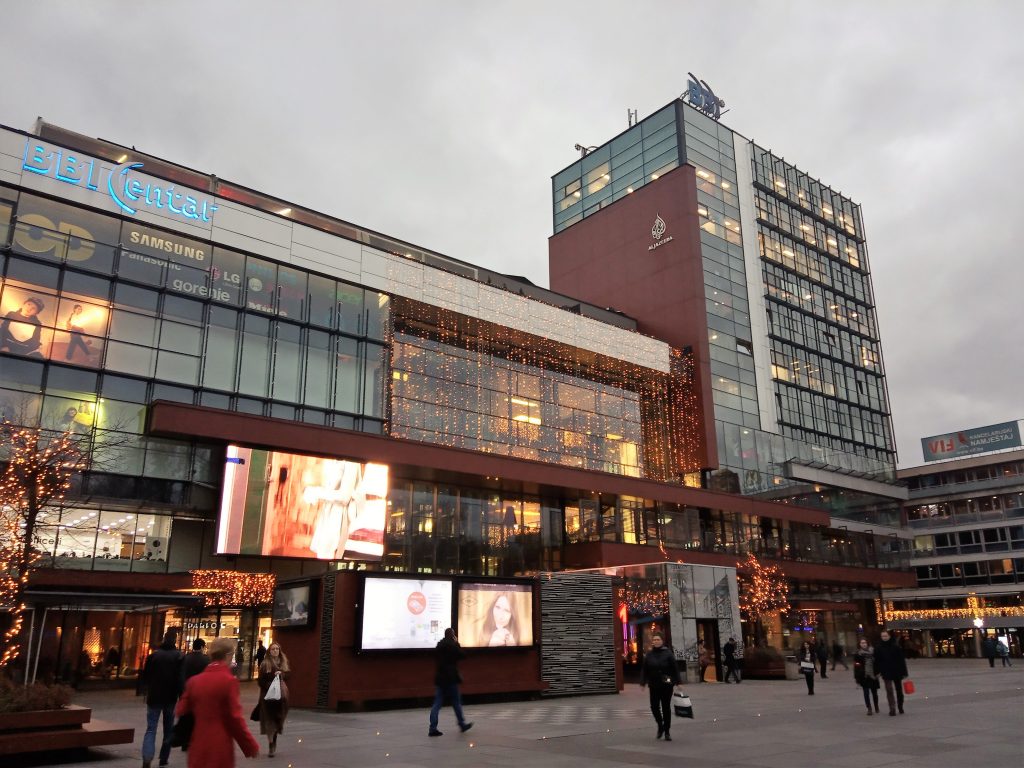Day 2
The first day in Sarajevo was in the spirit of Ottoman culture and history. The next day we had the program a bit sadder. Unfortunately, an inseparable part of Sarajevo is the warthat accompanied the collapse of the former Yugoslavia and the emergence of a new state Federation of Bosnia and Herzegovina. Sarajevo had about 530,000 inhabitants before the war. In the city lived side by side Serbs, Croats and Bosnians, Christians (Orthodox and Catholics), Muslims and Jews. This fact was probably not the will of politicians and unfortunately someone else

If you are interested in Sarajevo, have any questions or you want to share your experience, you will find us here.
Between 1992 and 1996, Sarajevo was besieged by the troops of the Republika Srpska (an autonomous part of Bosnia and Herzegovina inhabited by Serbs), which settled in the surrounding mountains and created a 55 km long chain of heavy equipment. The city was virtually all the time cut off from the basic conveniences of the time as electricity, water, gas. Most services did not work. An average of grenades per day which fell on the city was 329 (3777 in no more than 1 day).
Although the United nations came to assist, their assistance was minimal according to locals. Sarajlije (the people of Sarajevo) had a problem with livelihoods and things that seem obvious to us today have become rare in a moment. All the trees practically disappeared from the city because the winters were hard. Going for water meant fighting for life. People have learned to recycle water. Unfortunately, the streets marked "Pazi snajper" (caution sniper) have became a normal part of life.
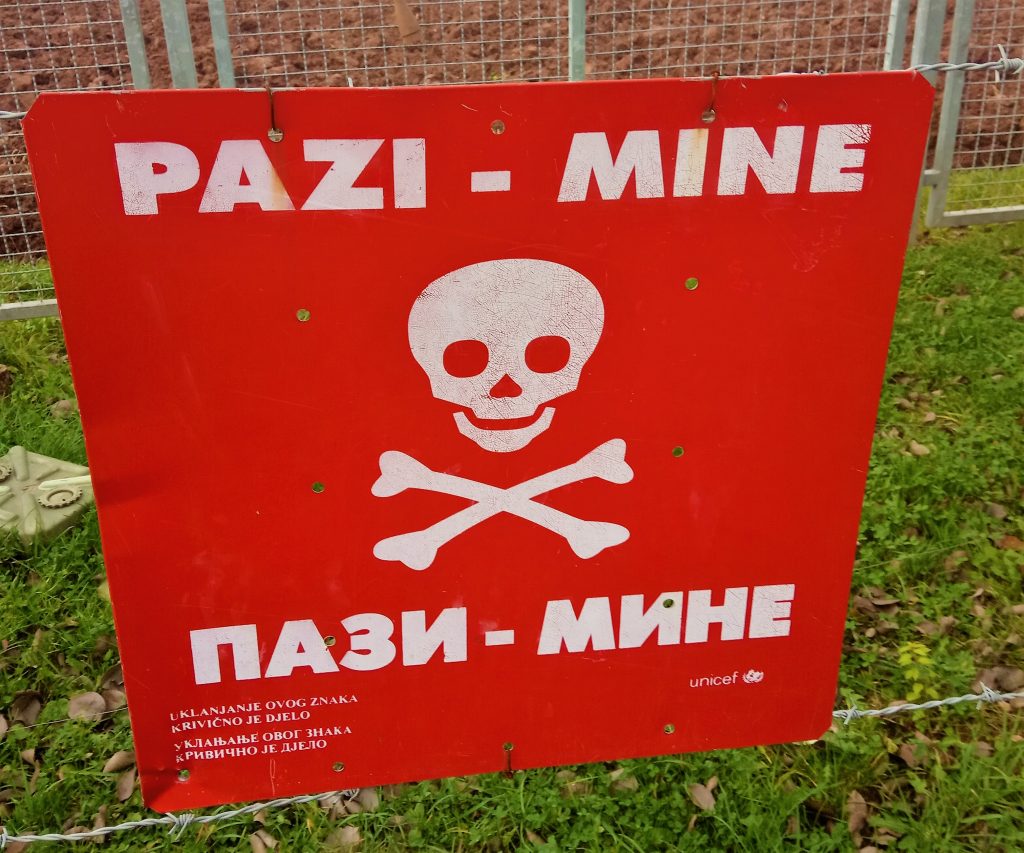
The Sarajevo agony finally ended after 1425 dayswhen nobody believed that it could end. It is one of the longest sieges in military history today. 11,541 people, including children, lost their lives in the city. More than 50,000 were injured. The population is currently about 275,000. Who could, he has escaped.
There was no building in Sarajevo that would not bear the traces of war. Paradoxically, Serbian soldiers also killed a number of Serbs. Finding the culprit in this conflict is probably unnecessary because, as usual, we only see the tip of the iceberg, although Ratko Mladic and Radovan Karadzic have already been convicted of this crime. Nevertheless, I think that everything what the media says is not true.
The next day (read about the 1st day - https://a-trips.sk/sarajevo-dan-1/) in this city was called Ratni dan (war day). In our itinerary there was written Tunel spasa, Muzej zločina protiv čovječnosti i genocida, Ratni muzej Sarajevo (Tunnel of hope, Museum of crimes against humanity and genocide, Museum of war in Sarajevo). Early in the morning, we were even considering visiting them when reading these names. Finally, we said "Vidjetćemo" (we will see) and went to the info point for tourists to see where the tunnel is.
„Morate ići tramvajem broj 3 na Ilidžu, na Ilidži uzeti autobus broj 32. Put vam će trajati oko sat vremena. Karte dobijete na kiosku.“ (You need to take tram no. 3 to Ilidža, there change for the bus no. 32. The whole journey takes about an hour. You can buy the ticket at the newsagent.) In addition to this useful information, we learned that from Ilidža, through a beautiful park, we can reach the the source of the river Bosnia and we took a few maps and brochures.
So the trip could start. Our little goal from the previous day was also the tram ride,which we have seen several times in Baščaršija. Trams in Sarajevo are in a worse condition than ours, but they go very often, which is very convenient. On the main road by the Miljacka River, a tram line of about 11 km runs through almost the entire city from Baščaršija at the east to Ilidža in the west. There are not many tram lines, and most of them follow this line.
So we get in our yellow tram with the inscription Ilidža and it was already the beginning of our trip "Skenderija, Marijin Dvor, Pofalići, Dolac Malta, Čengić villa, Otoka, Alipašino Polje, Stup, Ilidža". We headed out of the Ottoman area with small, gray, worn-out houses, a few seconds later we found ourselves among the buildings bearing the traces of the Habsburg monarchy, then Sarajevo´s quarter similar to our Petržalka and a modern Avaz Twist tower, below buildings under construction, small country houses, a plane with curious tourists landed in the horizon. All passengers in tram were silent all the time and looked through the windows into the unknown. When all of our fellow collaborators began to lift up from their seats in an organized way, it was a clear signal that we would be on Ilidža.
After about 40 minutes we found ourselves at a bus station with 3 platforms and lots of yellow buses. Thankfully, the buses were marked with numbers. Do not look for any informations on the platforms. The bus just comes to one of them and you just get on. It took about 15 minutes to the Butmir tunnel. The bus was very similar to ours.
This part of the city is already quite rural. There is no big way here. At the end of Ilidža there is a newly built aquapark and besides it only picturesque houses with gardens and panorama of mountains. We got off the bus in a large parking lot, which yawned empty. At the local bar we had to ask where the tunnel was. He willingly led us to his door.

Tunnel of hope is a tunnel built during the war under the airport connecting Dobrinja and Butmir to escape frombesieged city, but also to supply the city with food. The tunnel was forgotten after the war. Partially destroyed, partially covered. It fell into oblivion. It does not exist today. Later in the house of the Kolar family, where the entrance to the tunnel was, a museum was established. In this museum you can watch several videos, photographs, exhibits and the tunnel itself - only about 20 meters of the rest. Of course, you can not miss souvenirs that tourists like to buy. The museum is being expanded by another exposition, which is currently under construction. The entrance fee to the museum is symbolic.
We were expecting everything, but we were not ready for a plastered house with grenade holes, stoned windows in the middle of nowhere. In front of the house, the grenade hole was also colored red in the asphalt. It was called sarajevo´s rose. Each grenade hole was reddish in honor of the bombing victims. Next to the house there was a wooden shed leading to the courtyard, where we find the entrance and a cash desk.

Smiling Chinese tourists were passing by, but our first impressions were fearsome. We stood where a few years ago grenades exploded and people fought for their lives. Already at the cash desk we hesitated to go further. Of course they also offered us a guide, which we vigorously refused. The guide was either the members of the Kolar family themselves or the neighbour who witnessed the whole event. The exposure is not large and you will check it quickly. The tourists, who may not have had such an overview of the history of this city had an advantage.

This place is probably the saddestI've ever seen. Perhaps the best way to describe it is the silent and sad faces you will find all over the city. The silence was probably the quietest here. Stunned by the atmosphere, we prefer to get out of this museum.
As a rescue in this half-empty aisle we found a souvenir shop in the neighborhood, which according to the inlaid souvenirs looked more positive. There were no war souvenirs. The lady inside was very nice and cordial, just spoiled my sense of security with her talk and the photo of her dead husband. Her sincere and incredibly humble smile made me to buy more of her products than I had planned and left her some coins, which she obviously did not want to take. I wished her everything good and she, as a general before the battle, added “Everything will be fine".
An incredible Balkan feature - always believe in the good and encourage. Each of us knows the feeling when love breaks our heart. I had this feeling after closing the white plastic door of this suvenirnica (souvenir shop). Vučkov grad broke my heart.
The redeeming Bosnian guy offered to take us to the tram stop. And that was the last time I visited the Kolar family in Butmir. I don't know how we got back from Ilidža to Baščaršija. All the time I just looked at the faces of people and wondered how they could have survived in this city for so long and what burden they bear on their shoulders. I understood the silence and lowered my head in front of him.
The smile returned to my face only when I saw Sebilj, and in my life I never enjoyed such a common thing as getting off a rattling yellow tram. You probably understand that we changed our original itinerary, even if no one said it out loud. We decided to spend the second half of the day in the European part of the city.

The Sarači promenade ends a short distance from the tower clock and the Gazi Husrev vakuf, and at the same point the Ferhadija Promenade begins. Why does the same street have two names? Where Ferhadija begins, a completely different Sarajevo begins. This Sarajevo no longer has mosques, čevabdžinica and the scent of coffee. The appearance is very similar to Vienna, Budapest and Bratislava.The buildings are taller and resemble rather smaller aristocratic residences. Restaurants offer burgers, steaks and salads, you can drink wine and beer and spend money on sales. There is Christmas lighting on the pillars, you can hear the church bells from the distance.
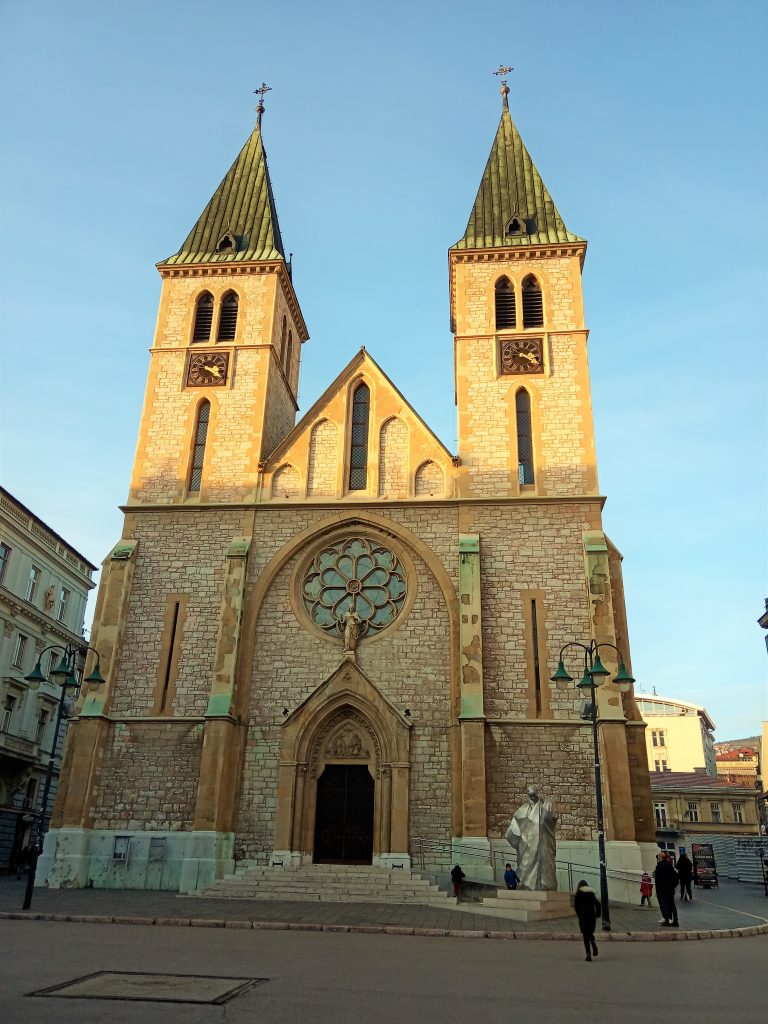
As we wandered through this “other city”, we found a group of men building a skating ring and a Christmas decorations on Trg oslobodjenja- Alija Izetbegović (Liberation Square Alija Izetbegović). We finally got the Christmas atmosphere. But before you come to the skating rink on the right you will discover the hidden Katedrala Srca Isusova - another beautiful symbol of a multicultural city.

On this day the Orthodox Cathedral of Saborna Crkva Rodjenja Presvete Bogorodice exacerbated the feeling of belonging to different faiths.I am not a believer, but perhaps God himself wanted us to have a nice experience from this day and bring us here. Curiously we peeked into the city market place, where we were attracted not only by a beautiful exterior but also by the smell of cheese, meat and other goodies.
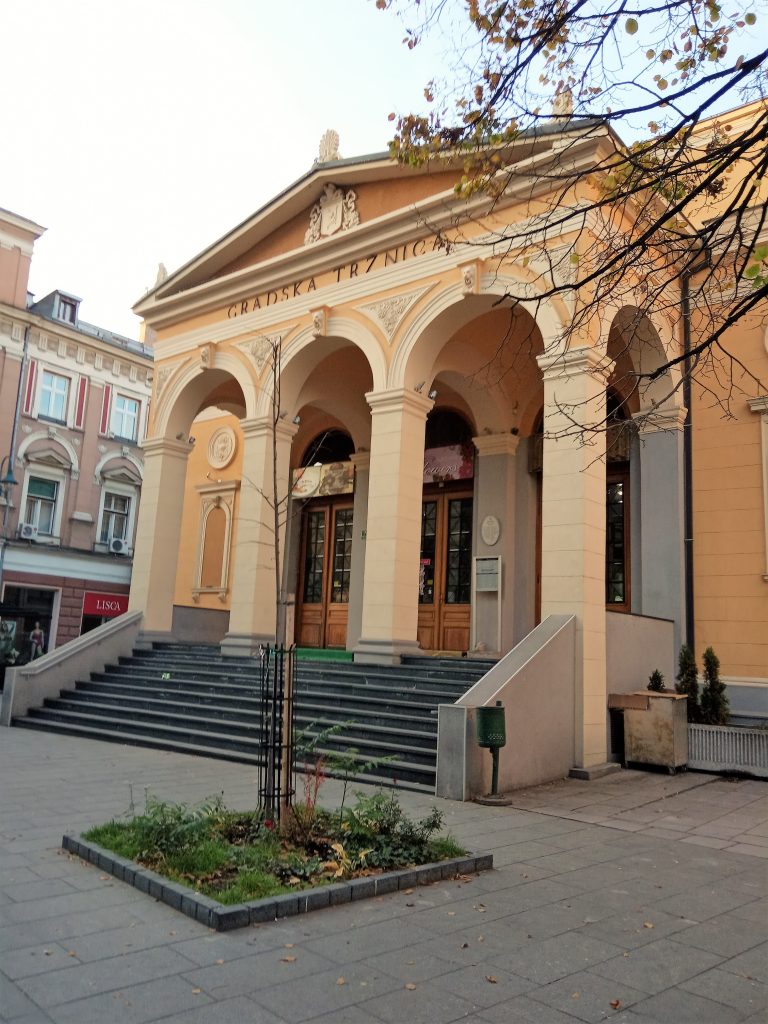
It was a signal that you need to find something to eat. Hungry belly took us this time to a small alley and even smaller yard to a small gourmet pub Vučko.Who could resist the light-catcher on the corner of the house with a lovely look of the little Vučko? The restaurant was very nice and modern. I was surprised by sea fruits that were part of the menu. Here, however, I tried to taste teleći ražnjići (calf kebab). Of course, there were a variety of soups, Vienna cutlet , pasta, wines and countless beers.Coffee was not so good, normal espresso. We didn't even come here for coffee.
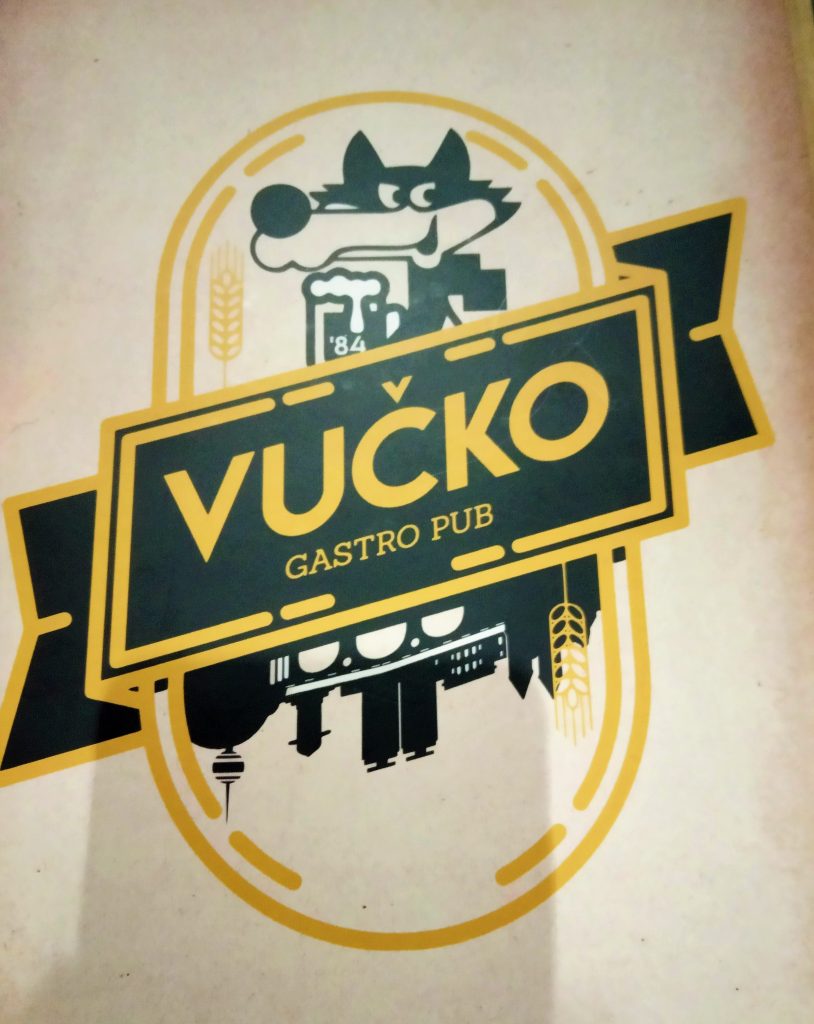
We also enjoyed modern European Sarajevo on a plate. The whole restaurant lived directly by the Olympics.On the walls photographs from the opening ceremony and pictures of Vučko himself were hanging. Map of the Olympic city welcomes you at the entrance with a detailed description of all the specific sites of the Olympic Games. On the table, the waiter punched a paper with several portraits of Vučko. Vučko even smiled at us from the sugar bowl. After leaving this restaurant we were rightly enticed for our next day in Sarajevo, whose motto was to be Winter Olympics '84.

With the good feeling this day ended quite well, we were returning again to Ferhadija, which in a few moments changed to Sarači. Abdesthana was already asleep when we arrived, and the muezin was singing the last time that day. From the window of our room we could see only small lights far away in the hills that awaited us the next day and prepared a great surprise for us.
